3 comets! See Lemmon, SWAN and ATLAS in your sky
There are 3 comets currently soaring through the inner solar system that you might be able to see in the coming weeks! Join us as we show you comets Lemmon, SWAN and the interstellar wonder 3I/ATLAS. Whether you’re new to comet-watching or a seasoned skywatcher, we’ll help you appreciate these icy visitors.
October 24 and 25 evenings: Young moon and Antares
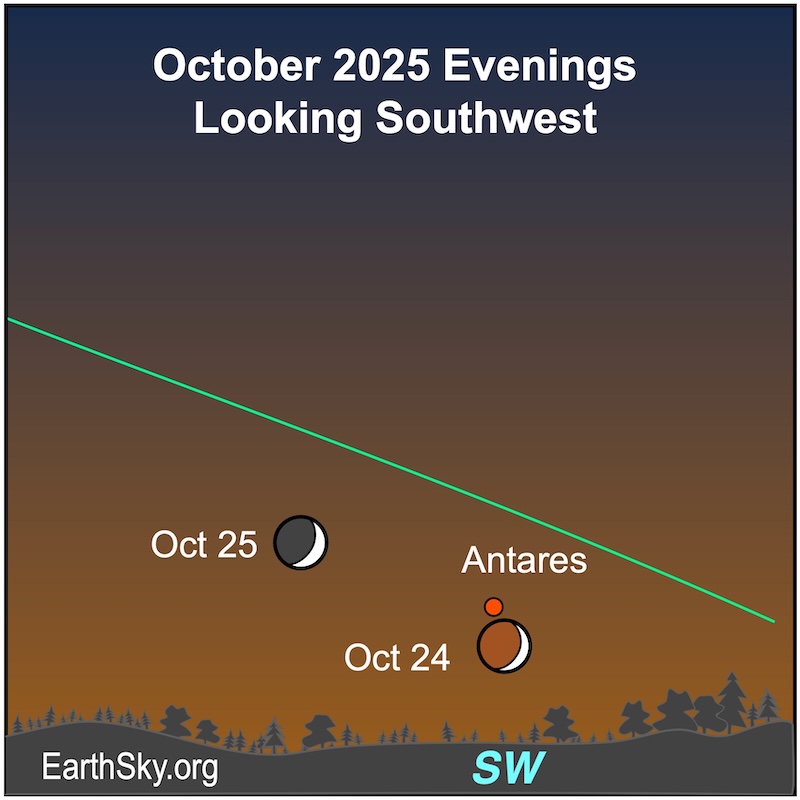 Shortly after sunset on October 25, the waxing crescent moon – now back in the west after sunset – will lie higher in the sky than yesterday, but still near red Antares. Antares is the Heart of the Scorpion in the constellation Scorpius. Look for them above the horizon not long after the sun goes down. Chart via EarthSky.
Shortly after sunset on October 25, the waxing crescent moon – now back in the west after sunset – will lie higher in the sky than yesterday, but still near red Antares. Antares is the Heart of the Scorpion in the constellation Scorpius. Look for them above the horizon not long after the sun goes down. Chart via EarthSky.
Read more: Massive ruby red Antares is the Scorpion’s Heart
Our charts are mostly set for the northern half of Earth. To see a precise view – and time – from your location, try Stellarium Online.
October evening planets
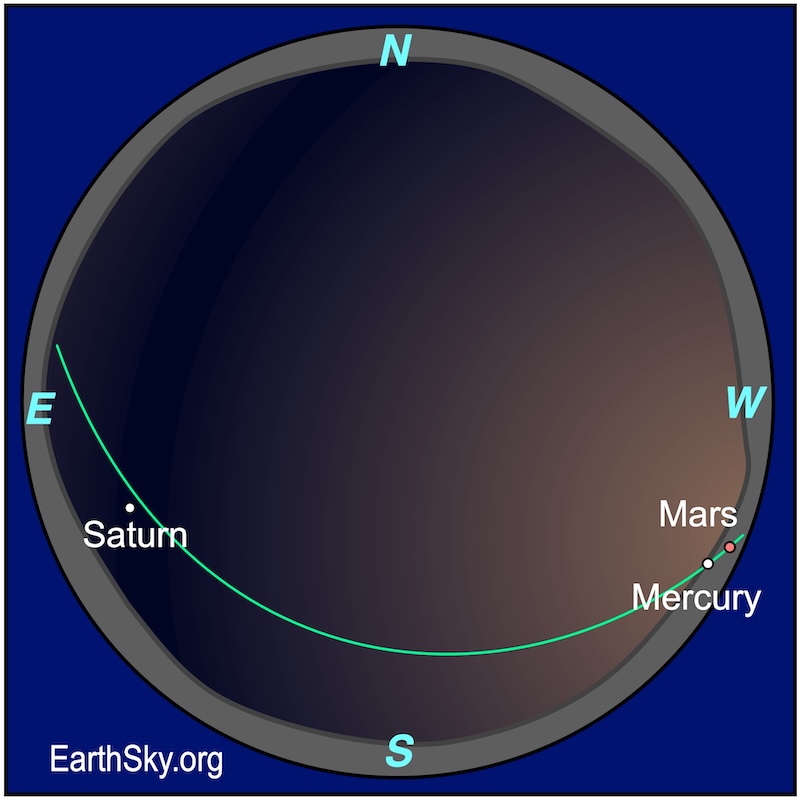 Sphere chart showing 3 planets in the October evening sky as viewed from the Northern Hemisphere: Saturn is in the southeast with Mercury and dim Mars very low in the bright southwestern twilight. Saturn is well placed for evening viewing this month, and its rings are titled 1 degree from edge-on by mid-month. Mars is increasingly difficult to spot in the evening twilight this month. Brighter Mercury joined Mars around mid-month and was closest to it – about 2 degrees away – on the evenings of October 20 and 21. Plus, Mercury’s October 29 greatest evening elongation is the best evening apparition of Mercury this year for the Southern Hemisphere. The planets all lie along the path the sun travels in the daytime (the green line on our chart). Chart via EarthSky.
Sphere chart showing 3 planets in the October evening sky as viewed from the Northern Hemisphere: Saturn is in the southeast with Mercury and dim Mars very low in the bright southwestern twilight. Saturn is well placed for evening viewing this month, and its rings are titled 1 degree from edge-on by mid-month. Mars is increasingly difficult to spot in the evening twilight this month. Brighter Mercury joined Mars around mid-month and was closest to it – about 2 degrees away – on the evenings of October 20 and 21. Plus, Mercury’s October 29 greatest evening elongation is the best evening apparition of Mercury this year for the Southern Hemisphere. The planets all lie along the path the sun travels in the daytime (the green line on our chart). Chart via EarthSky.
October morning planets
 You can see 2 bright planets in the October morning sky. As seen from around the globe, Venus will lie low in the east, and Jupiter will shine higher in the morning sky. Venus rises a few hours before sunrise. Jupiter rises around midnight and is high in the sky before dawn. The planets all lie along the path the sun travels in the daytime (the green line on our chart). Chart via EarthSky.
You can see 2 bright planets in the October morning sky. As seen from around the globe, Venus will lie low in the east, and Jupiter will shine higher in the morning sky. Venus rises a few hours before sunrise. Jupiter rises around midnight and is high in the sky before dawn. The planets all lie along the path the sun travels in the daytime (the green line on our chart). Chart via EarthSky.
Our charts are mostly set for the northern half of Earth. To see a precise view – and time – from your location, try Stellarium Online.
October 26 and 27 evenings: Moon and Teapot
 On the evenings of October 26 and 27, the thickening waxing crescent moon will move through the Teapot asterism of Sagittarius. Chart via EarthSky.
On the evenings of October 26 and 27, the thickening waxing crescent moon will move through the Teapot asterism of Sagittarius. Chart via EarthSky.
Read more: Teapot of Sagittarius points to Milky Way Center
October 29: 1st quarter moon
The moment of 1st quarter moon will fall at 16:21 UTC on October 29, 2025. That’s 11:21 a.m. CDT. Did you know you can see an X and V on the 1st quarter moon? Here’s how to see them. A 1st quarter moon rises around noon your local time and sets around midnight. Watch for a 1st quarter moon high in the sky at sundown.
Want more? Here are 4 keys to understanding the moon’s phases.
October 29: Mercury reaches greatest elongation from evening sun
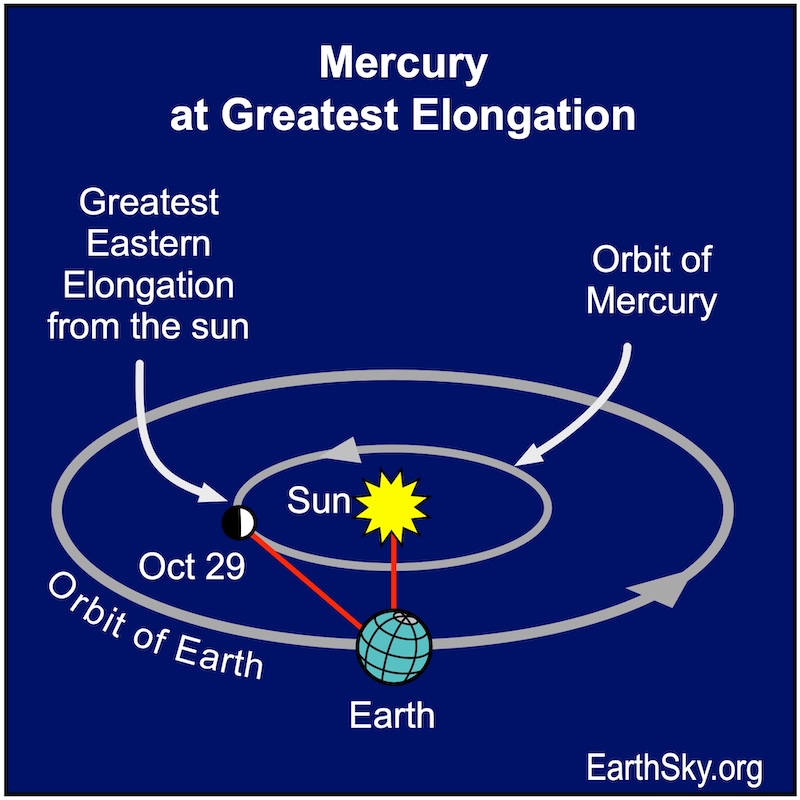 Mercury will make its widest angle from the sun in the western sky on October 29. This point in its orbit is called greatest eastern elongation. This will be the best evening apparition of Mercury for the Southern Hemisphere in 2025. Chart via EarthSky.
Mercury will make its widest angle from the sun in the western sky on October 29. This point in its orbit is called greatest eastern elongation. This will be the best evening apparition of Mercury for the Southern Hemisphere in 2025. Chart via EarthSky.
Read more: Mercury is farthest from the sunset on October 29
October 29 and 30 evenings: Moon and Capricornus
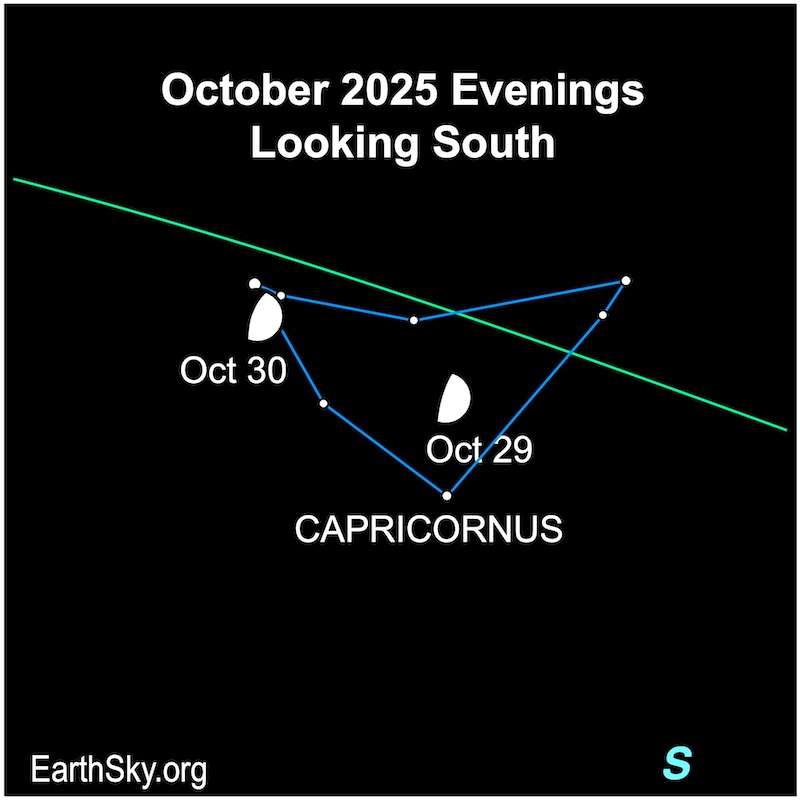 On the evening of October 29, the 1st quarter moon will lie in the center of Capricornus the Sea-goat. Then on the next evening, October 30, the waxing gibbous moon will move away from the arrow-shaped pattern of stars of Capricornus. Chart via EarthSky.
On the evening of October 29, the 1st quarter moon will lie in the center of Capricornus the Sea-goat. Then on the next evening, October 30, the waxing gibbous moon will move away from the arrow-shaped pattern of stars of Capricornus. Chart via EarthSky.
Read more: Capricornus the Sea-goat has an arrowhead shape
October 31 evening: Moon, Saturn and Fomalhaut
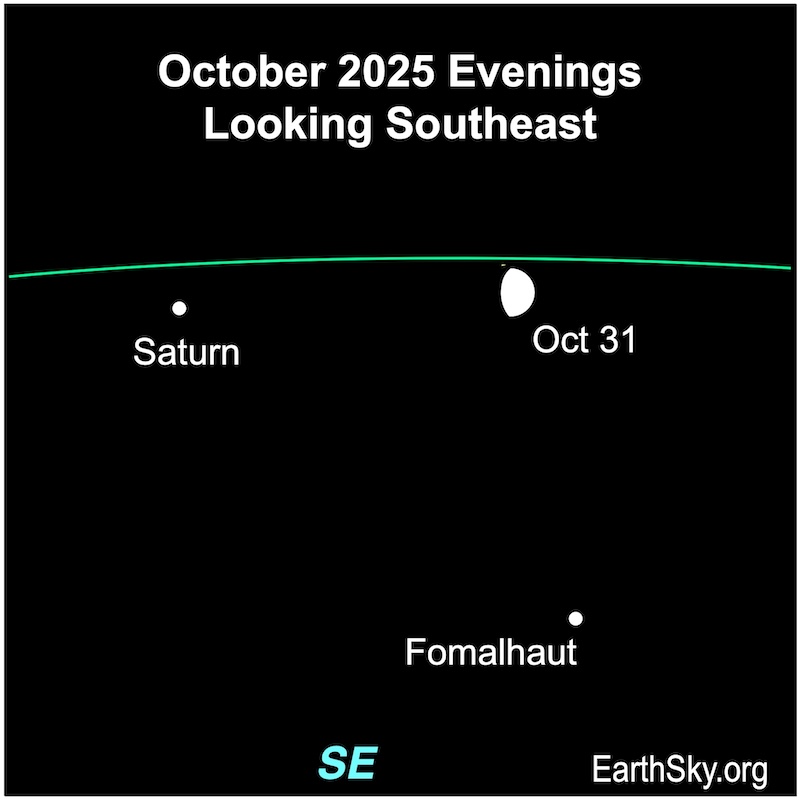 On the last evening of October – on Halloween – the waxing gibbous moon will float near Saturn and the star Fomalhaut. Chart via EarthSky.
On the last evening of October – on Halloween – the waxing gibbous moon will float near Saturn and the star Fomalhaut. Chart via EarthSky.
Read more: Fomalhaut is the Loneliest Star … but not in 2025
Our charts are mostly set for the northern half of Earth. To see a precise view – and time – from your location, try Stellarium Online.
November 1 and 2 evenings: Moon and Saturn
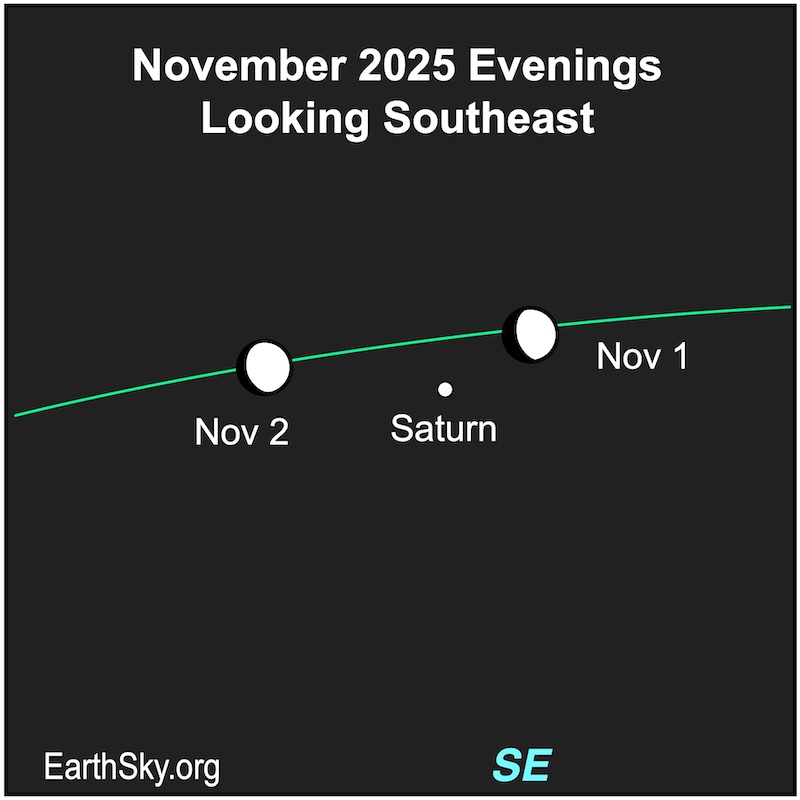 The fat waxing gibbous moon will shine brightly near Saturn on the evenings of November 1 and 2. Look for them as darkness falls. They’ll set a few hours after midnight. Chart via EarthSky.
The fat waxing gibbous moon will shine brightly near Saturn on the evenings of November 1 and 2. Look for them as darkness falls. They’ll set a few hours after midnight. Chart via EarthSky.
Read more: Saturn’s rings are weird and wonderful: 10 facts here
Our charts are mostly set for the northern half of Earth. To see a precise view – and time – from your location, try Stellarium Online.
November 2: Daylight Saving Time ends
Remember to set your clocks back one hour. Read more: Daylight Time ends Sunday: 7 tips to help you adjust.
November evening planets
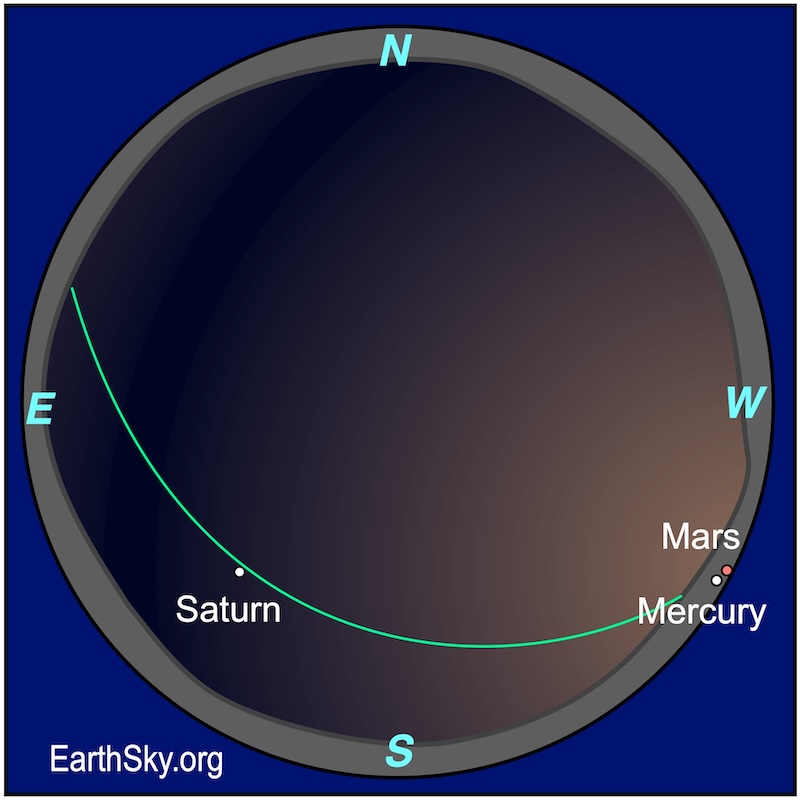 Here’s an overhead chart showing 3 planets in the early to mid-November evening sky as viewed from the Northern Hemisphere. Saturn is in the southeast with Mercury and dim Mars very low in the bright southwestern twilight. Saturn is well placed for evening viewing this month, and its rings are titled close to edge-on the second half of the month. Mars is increasingly difficult to spot in the evening twilight and will disappear sometime in early November. Brighter Mercury – now easiest to see from the Southern Hemisphere – will be closest to Mars on the evening of November 12. But they’ll likely be difficult if not impossible to see in bright twilight by then. Mercury’s recent October 29 greatest evening elongation was the best evening apparition of Mercury this year for the Southern Hemisphere. The 3 planets all lie along the path the sun travels in the daytime (the green line on our chart). Chart via EarthSky.
Here’s an overhead chart showing 3 planets in the early to mid-November evening sky as viewed from the Northern Hemisphere. Saturn is in the southeast with Mercury and dim Mars very low in the bright southwestern twilight. Saturn is well placed for evening viewing this month, and its rings are titled close to edge-on the second half of the month. Mars is increasingly difficult to spot in the evening twilight and will disappear sometime in early November. Brighter Mercury – now easiest to see from the Southern Hemisphere – will be closest to Mars on the evening of November 12. But they’ll likely be difficult if not impossible to see in bright twilight by then. Mercury’s recent October 29 greatest evening elongation was the best evening apparition of Mercury this year for the Southern Hemisphere. The 3 planets all lie along the path the sun travels in the daytime (the green line on our chart). Chart via EarthSky.
November morning planets
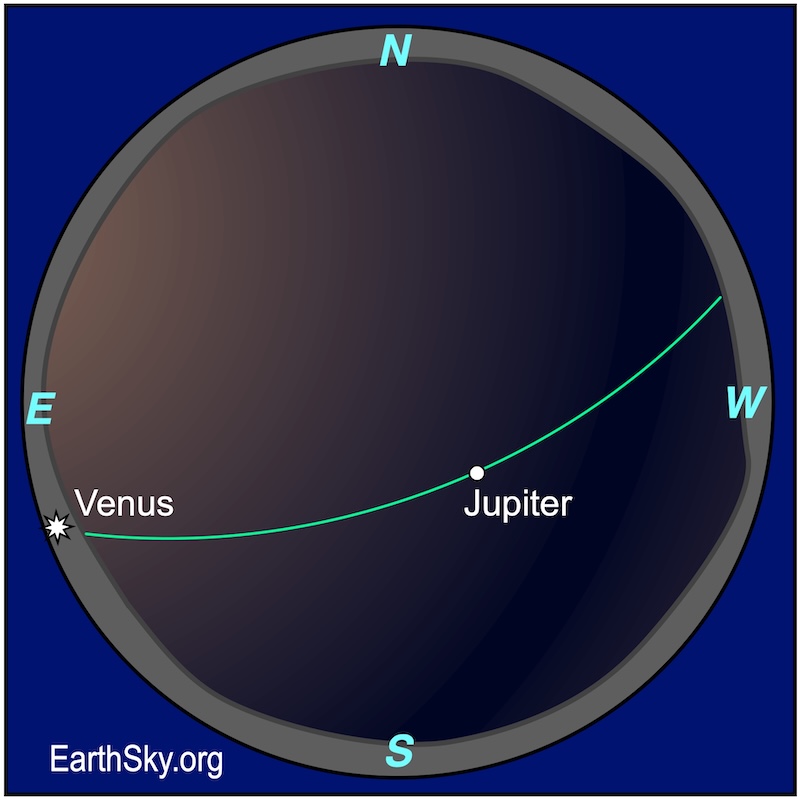 This is the overhead view showing 2 bright planets in the November morning sky as seen from the Northern Hemisphere. Venus will lie low on the eastern horizon in the morning twilight, and Jupiter will shine higher in the southern sky. Venus will sink closer to the morning sunrise each day until it slips from view later this month. The 2 planets lie along the path the sun travels in the daytime (the green line on our chart). Chart via EarthSky.
This is the overhead view showing 2 bright planets in the November morning sky as seen from the Northern Hemisphere. Venus will lie low on the eastern horizon in the morning twilight, and Jupiter will shine higher in the southern sky. Venus will sink closer to the morning sunrise each day until it slips from view later this month. The 2 planets lie along the path the sun travels in the daytime (the green line on our chart). Chart via EarthSky.
November 5 all night: Full Hunter’s Moon is closest supermoon of 2025
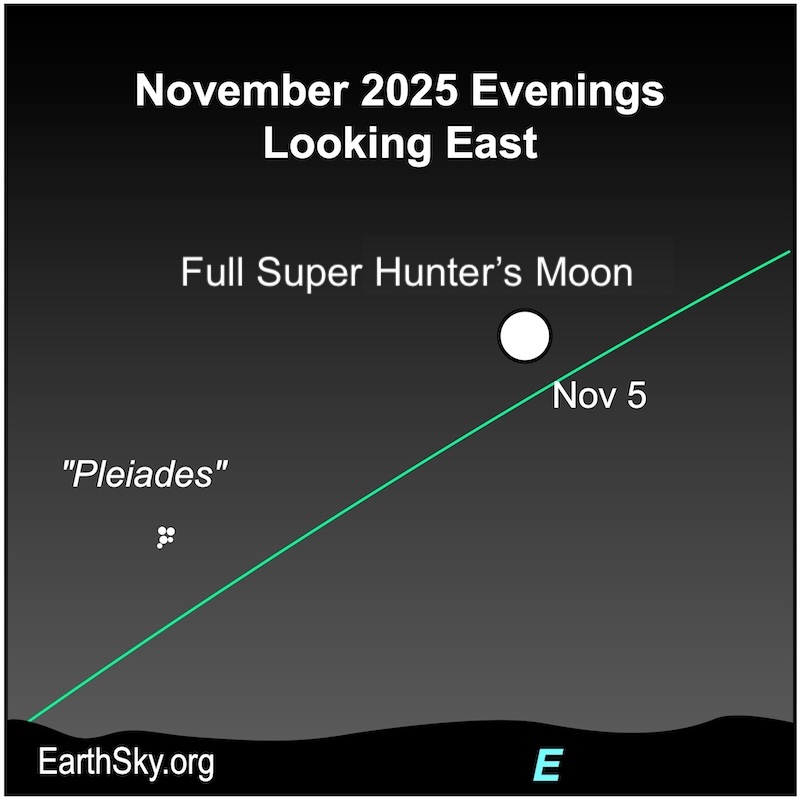 TThe crest of the full Super Hunter’s Moon occurs at 13:19 UTC (7:19 a.m. CST) on November 5. It’ll be the closest full supermoon of 2025 and the 2nd of 4 supermoons in a row. The moon will be visible all night and will be near the Pleiades that evening. Chart via EarthSky.
TThe crest of the full Super Hunter’s Moon occurs at 13:19 UTC (7:19 a.m. CST) on November 5. It’ll be the closest full supermoon of 2025 and the 2nd of 4 supermoons in a row. The moon will be visible all night and will be near the Pleiades that evening. Chart via EarthSky.
November 5: Moon reaches perigee
The moon will reach perigee – its closest point to us in its elliptical orbit around Earth – at 22 UTC on November 5, 2025, when it’s 221,725 miles (356,833 km) away. And it’ll be the closest full supermoon of 2025. Expect high tides.
Early November meteors … the Southern and Northern Taurids
The South Taurids’ predicted peak is for 13 UTC on November 5, 2025. The North Taurids’ predicted peak is for 12 UTC on November 9, 2025. Both the South and North Taurids don’t have very definite peaks. They are especially noticeable from late October into early November, when they overlap.
Read more: All you need to know about the Taurid meteors
November 6 and 7 evenings: Moon, Jupiter, Capella, Betelgeuse and Aldebaran
 On the evenings of November 6 and 7, the waning gibbous moon will be surrounded by Jupiter and the bright stars Capella, Betelgeuse and Aldebaran. You can see them through dawn the next morning. Chart via EarthSky.
On the evenings of November 6 and 7, the waning gibbous moon will be surrounded by Jupiter and the bright stars Capella, Betelgeuse and Aldebaran. You can see them through dawn the next morning. Chart via EarthSky.
Read more: Companion for Betelgeuse confirmed! Beloved red star has a blue-white buddy
Our charts are mostly set for the northern half of Earth. To see a precise view – and time – from your location, try Stellarium Online.
November 8 and 9 evenings: Moon, Jupiter and twin stars
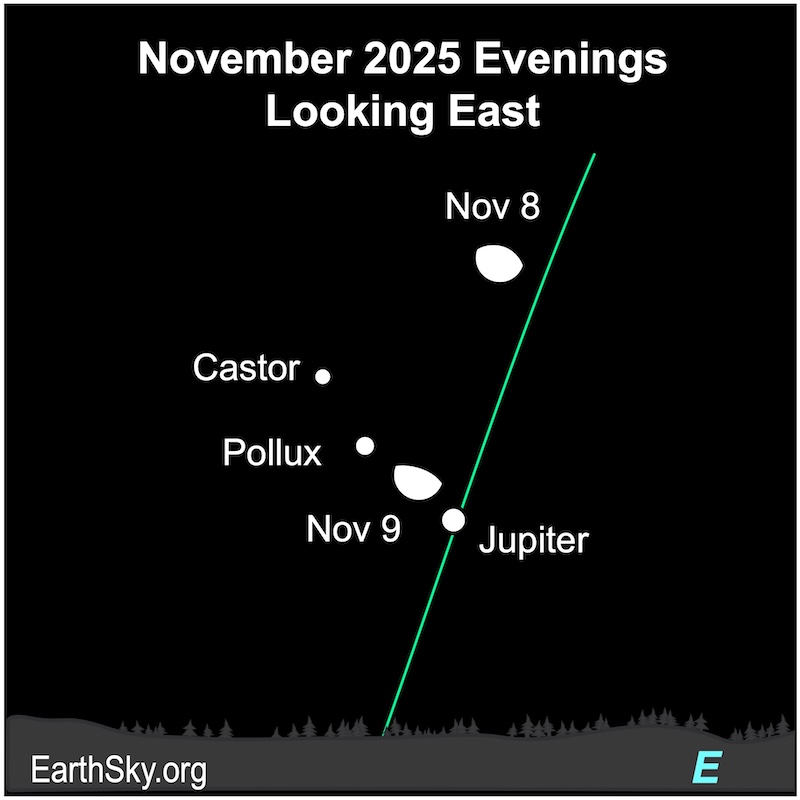 On the evening of November 8, the waning gibbous moon will lie near bright Jupiter and the twin stars of Gemini, Castor and Pollux. On the next evening, November 9, the moon will float among the trio in the evening sky. You can see them through dawn the next morning. Chart via EarthSky.
On the evening of November 8, the waning gibbous moon will lie near bright Jupiter and the twin stars of Gemini, Castor and Pollux. On the next evening, November 9, the moon will float among the trio in the evening sky. You can see them through dawn the next morning. Chart via EarthSky.
November 10 evening: Moon, Pollux, Castor and the Beehive
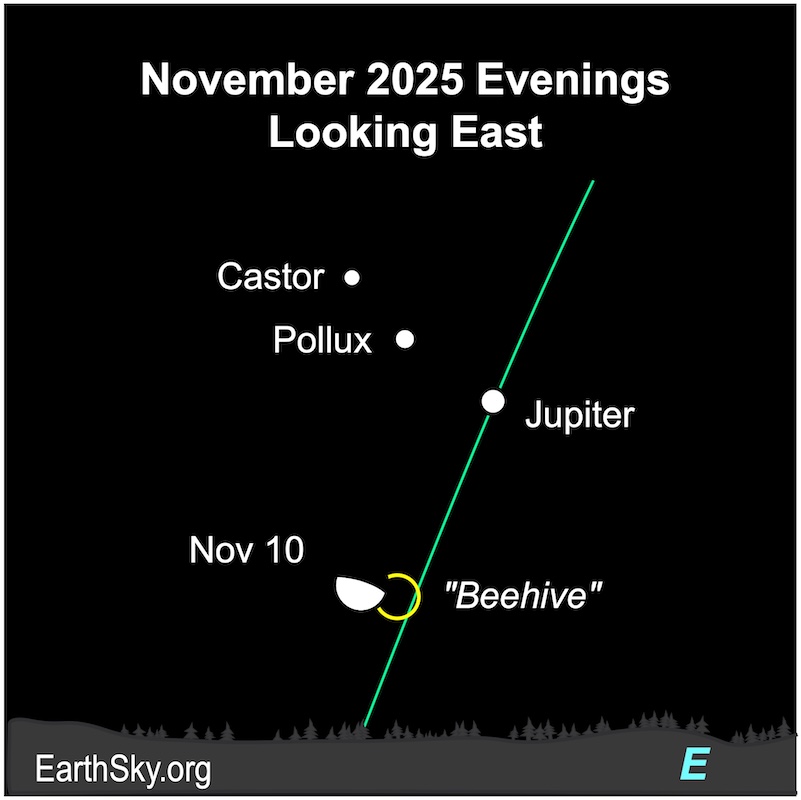 Late on the evening of November 10, the waning gibbous will shine near Jupiter and the twin stars of Gemini, Castor and Pollux. And the moon will also cozy up to the Beehive star cluster, though its bright light will wash out the fainter stars. You can see them through dawn the next morning. Chart via EarthSky.
Late on the evening of November 10, the waning gibbous will shine near Jupiter and the twin stars of Gemini, Castor and Pollux. And the moon will also cozy up to the Beehive star cluster, though its bright light will wash out the fainter stars. You can see them through dawn the next morning. Chart via EarthSky.
Read more: The Beehive cluster: A swarm of 1,000 stars
November 12: Watch for the 3rd quarter moon
The moment of 3rd quarter moon will fall at 5:28 UTC on November 12, 2025. That’s 11:28 p.m. CST on November 11. It’ll rise after midnight your local time and set around noon. Look for it high in the sky before dawn.
Want more? Here are 4 keys to understanding the moon’s phases.
November 12 and 13 mornings: Moon and Regulus
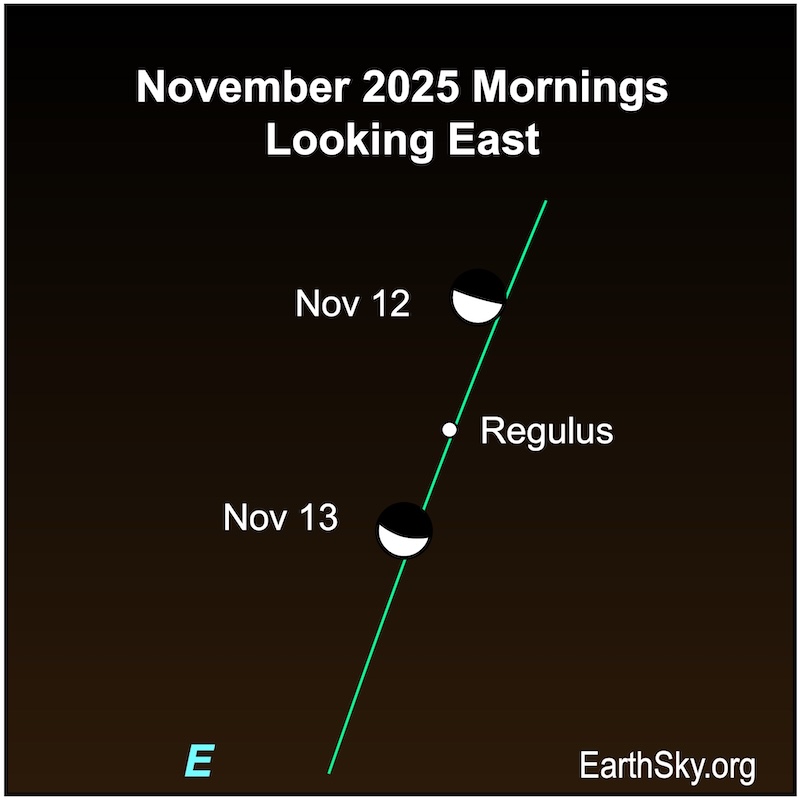 In the early morning hours of November 12 and 13, the 3rd quarter moon will be near the bright star Regulus, the brightest star in Leo the Lion. Chart via EarthSky.
In the early morning hours of November 12 and 13, the 3rd quarter moon will be near the bright star Regulus, the brightest star in Leo the Lion. Chart via EarthSky.
Read more: Meet Regulus, Leo the Lion’s Heart and brightest star
November 16-17 overnight: Leonid meteor shower
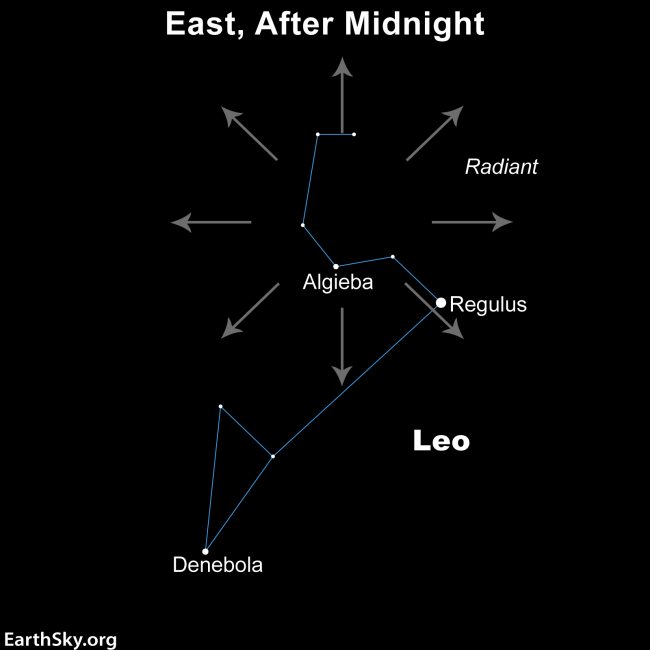 The Leonid meteor shower peak is predicted for 18 UTC on November 17, 2025. Watch late on the night of November 16 until dawn on November 17. The morning of November 18 might be worthwhile, too. Leonids stream from a single point in the sky – their radiant point – in the constellation Leo the Lion. Leo rises just before midnight in mid-November. Regulus, the brightest star in Leo the Lion, dots a backward question mark of stars known as the Sickle.
The Leonid meteor shower peak is predicted for 18 UTC on November 17, 2025. Watch late on the night of November 16 until dawn on November 17. The morning of November 18 might be worthwhile, too. Leonids stream from a single point in the sky – their radiant point – in the constellation Leo the Lion. Leo rises just before midnight in mid-November. Regulus, the brightest star in Leo the Lion, dots a backward question mark of stars known as the Sickle.
Read more: All you need to know about Leonid meteors
November 16 and 17 mornings: Moon and Spica
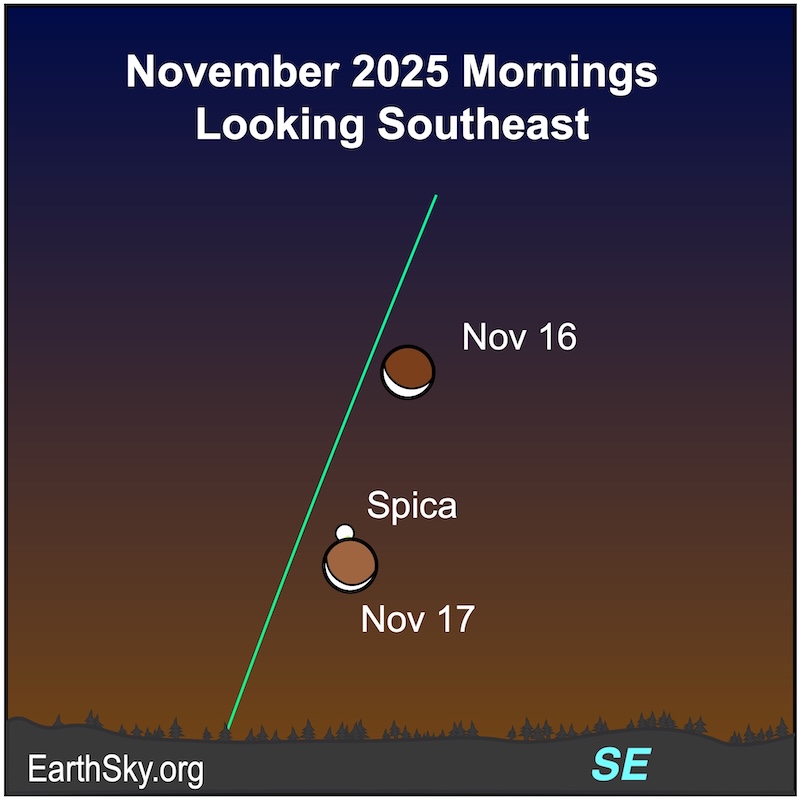 In the early morning hours of November 16 and 17, the waning crescent moon will hang near the bright star Spica. Do you notice a lovely glow on the unlit side of the moon? That’s earthshine! It’s reflected light from Earth. Chart via EarthSky.
In the early morning hours of November 16 and 17, the waning crescent moon will hang near the bright star Spica. Do you notice a lovely glow on the unlit side of the moon? That’s earthshine! It’s reflected light from Earth. Chart via EarthSky.
Mid-to-late November evening planets
 This overhead chart shows the location of 2 planets in the mid- to late November evening sky from the Northern Hemisphere. Jupiter is rising in the east, and Saturn is in the southwest. Jupiter will rise earlier each night and be a bright light among the stars of Gemini. Saturn is well placed for evening viewing this month, and its rings are titled almost edge-on. The planets all lie along the path the sun travels in the daytime (the green line on our chart). Chart via EarthSky.
This overhead chart shows the location of 2 planets in the mid- to late November evening sky from the Northern Hemisphere. Jupiter is rising in the east, and Saturn is in the southwest. Jupiter will rise earlier each night and be a bright light among the stars of Gemini. Saturn is well placed for evening viewing this month, and its rings are titled almost edge-on. The planets all lie along the path the sun travels in the daytime (the green line on our chart). Chart via EarthSky.
November 20: The most distant new moon of 2025
The moment of new moon will fall at 6:47 UTC on October 21, 2025. That’s 12:47 a.m. CST. New moons rise and set with the sun. Nights around the new moon are perfect for stargazing, and this one is near the peak of the Leonid meteor shower. Plus, this is the second – and farthest – of three new micromoons – or most distant new moons – in 2025. See EarthSky’s best places to stargaze.
Want more? Here are 4 keys to understanding the moon’s phases.
November 20: Moon reaches apogee
The moon will reach apogee – its farthest distance from Earth in its elliptical orbit – at 3 UTC on November 20, 2025, when it’s 252,706 miles (406,691 km) away.
November 20: Mercury at inferior conjunction
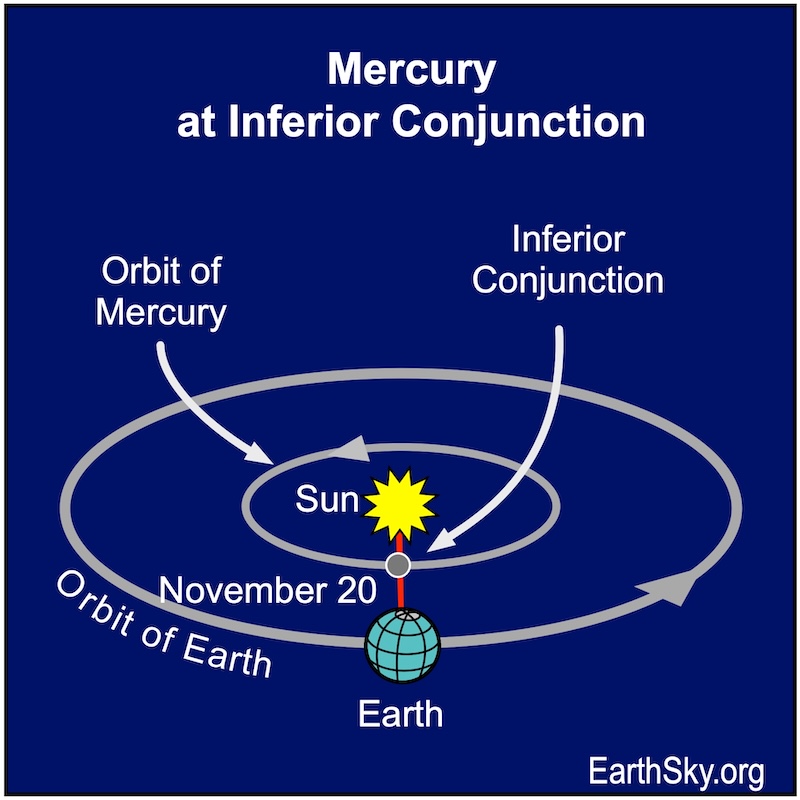 Mercury will lie on the near side of the sun, passing just north of it from Earth’s point of view, at 9 UTC on November 20. This point in its orbit is known as inferior conjunction. Because it’s so near the sun, it can’t be seen. Chart via EarthSky.
Mercury will lie on the near side of the sun, passing just north of it from Earth’s point of view, at 9 UTC on November 20. This point in its orbit is known as inferior conjunction. Because it’s so near the sun, it can’t be seen. Chart via EarthSky.
November 22 and 23 evenings: Moon and the Teapot
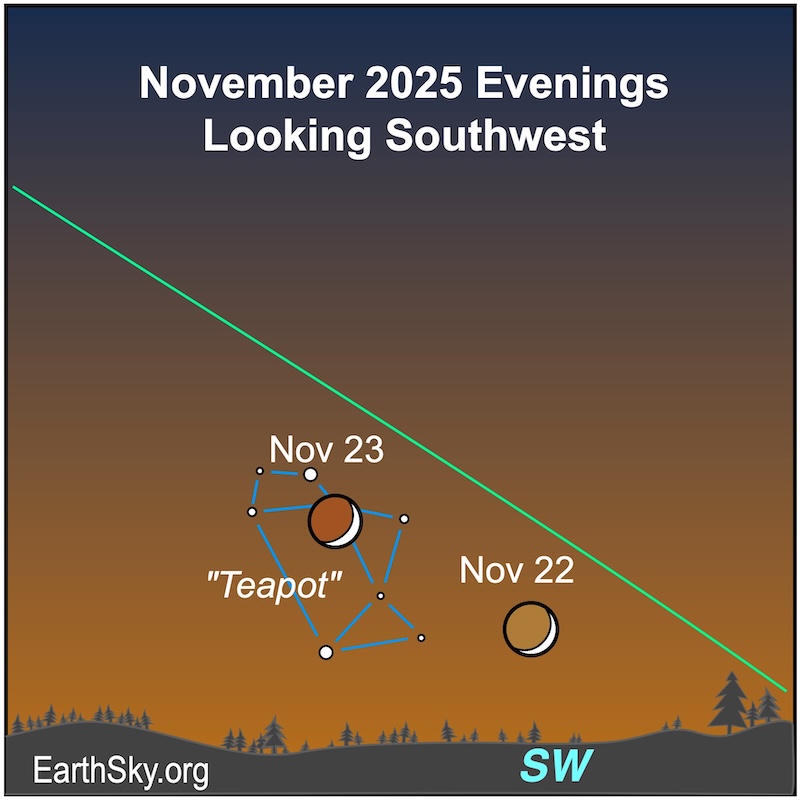 Shortly after sunset, on the evenings of November 22 and 23, the thickening waxing crescent moon will move through the Teapot asterism of Sagittarius. You can look for the Teapot once the bright light of the moon has moved on. It sets a little earlier every evening in November. Catch it before it’s gone. Chart via EarthSky.
Shortly after sunset, on the evenings of November 22 and 23, the thickening waxing crescent moon will move through the Teapot asterism of Sagittarius. You can look for the Teapot once the bright light of the moon has moved on. It sets a little earlier every evening in November. Catch it before it’s gone. Chart via EarthSky.
Read more: Teapot of Sagittarius points to Milky Way Center
Our charts are mostly set for the northern half of Earth. To see a precise view – and time – from your location, try Stellarium Online.
November 25 and 26 evenings: Moon and Capricornus
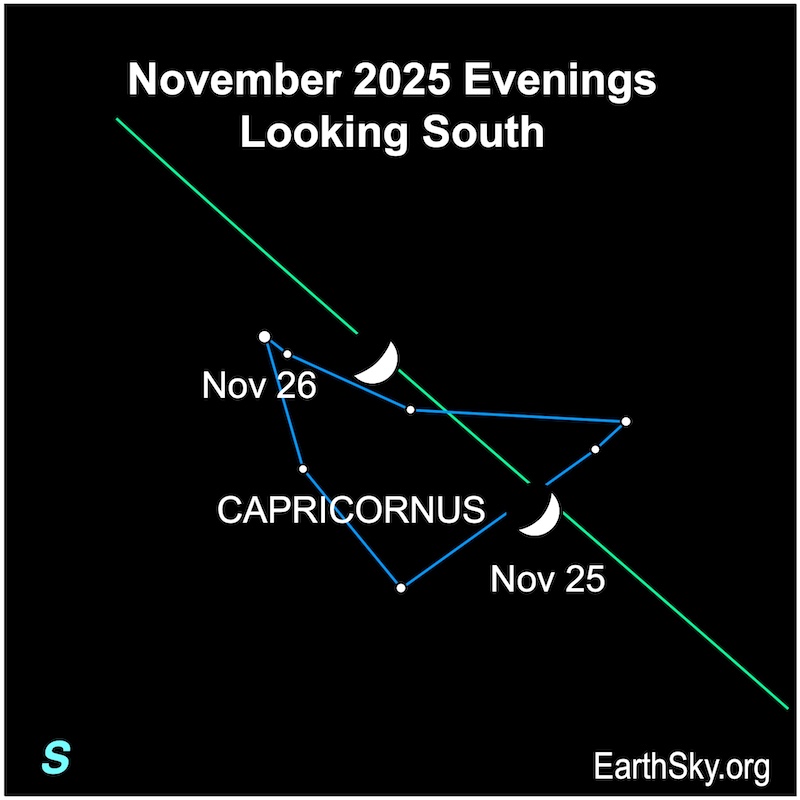 On the evenings of November 25 and 26, the waxing crescent moon will move in front of the arrow-shaped pattern of stars of Capricornus. You’ll need a dark sky to spot the stars of Capricornus. Chart via EarthSky.
On the evenings of November 25 and 26, the waxing crescent moon will move in front of the arrow-shaped pattern of stars of Capricornus. You’ll need a dark sky to spot the stars of Capricornus. Chart via EarthSky.
Read more: Capricornus the Sea-goat has an arrowhead shape
November 28: 1st quarter moon
The moment of 1st quarter moon will fall at 6:59 UTC on November 28, 2025. That’s 12:59 a.m. CST. Did you know you can see an X and V on the 1st quarter moon? Here’s how to see them. A 1st quarter moon rises around noon your local time and sets around midnight. Watch for a 1st quarter moon high in the sky at sundown.
Want more? Here are 4 keys to understanding the moon’s phases.
November 28 and 29 evenings: Moon and Saturn
 The waxing gibbous moon floats near the steady golden light of Saturn on the evenings of November 28 and 29. They’ll set around midnight. Chart via EarthSky.
The waxing gibbous moon floats near the steady golden light of Saturn on the evenings of November 28 and 29. They’ll set around midnight. Chart via EarthSky.
Read more: Saturn’s rings are weird and wonderful: 10 facts here
Our charts are mostly set for the northern half of Earth. To see a precise view – and time – from your location, try Stellarium Online.
October stars and constellations
If you’re out stargazing on any October evening, look for these stars and constellations high in the evening sky while facing north.
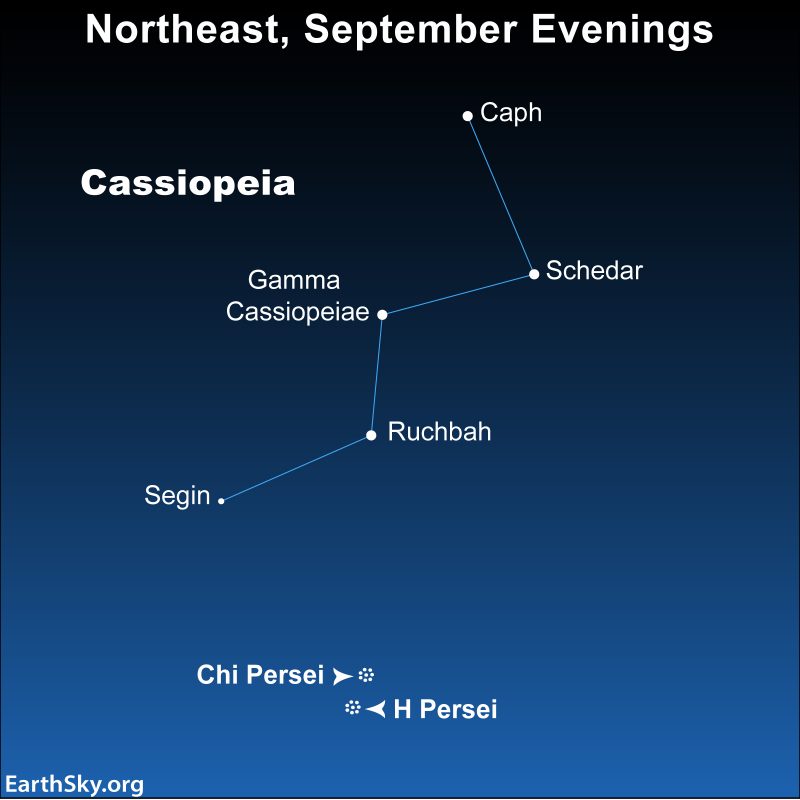 You can find Cassiopeia the Queen high in the northeast during the month of October. If you have a dark sky, look below Cassiopeia for a famous binocular object. This object is called the Double Cluster in Perseus. Chart via EarthSky.
You can find Cassiopeia the Queen high in the northeast during the month of October. If you have a dark sky, look below Cassiopeia for a famous binocular object. This object is called the Double Cluster in Perseus. Chart via EarthSky.
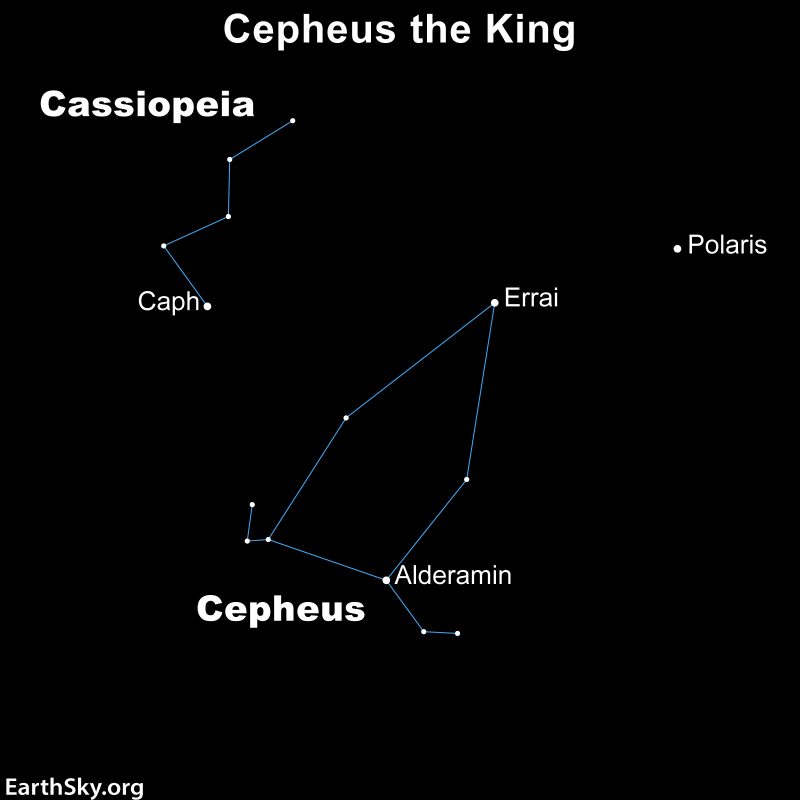 The house-shaped constellation Cepheus the King lies in the northern sky by the constellation Cassiopeia. Gamma Cephei, or Errai marks the peak of the roof of the house. And Errai is very near Polaris, the North Star.
The house-shaped constellation Cepheus the King lies in the northern sky by the constellation Cassiopeia. Gamma Cephei, or Errai marks the peak of the roof of the house. And Errai is very near Polaris, the North Star.
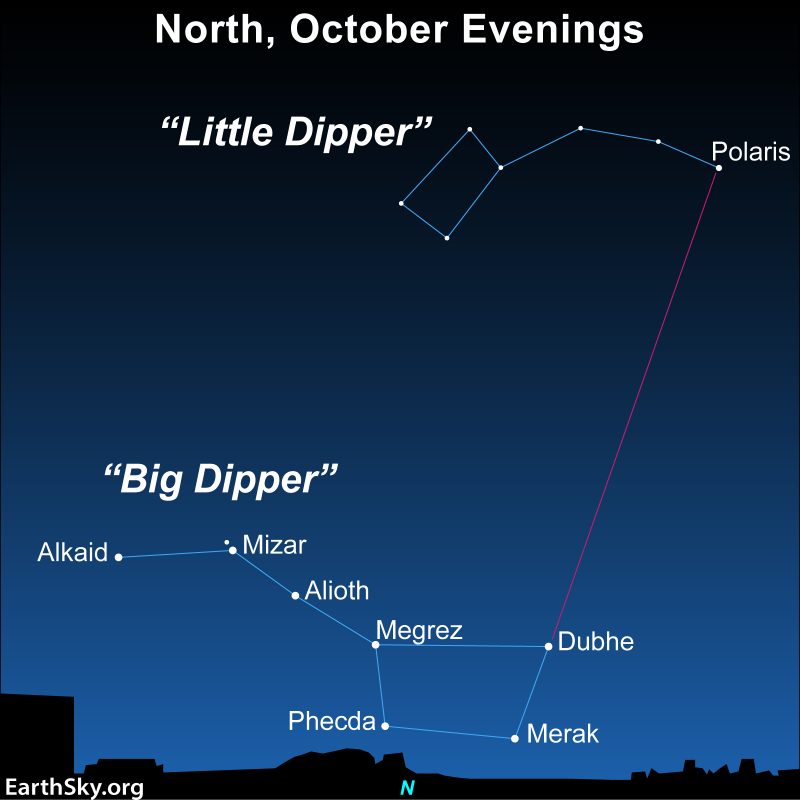 Although the Big Dipper is low on the horizon – or below the horizon – for mid-northern latitudes now, the Little Dipper is high in the northern sky. In fact, the Big Dipper is tough to spot on late October evenings because it rides so low in the north. As always, the 2 outer stars in the Dipper’s bowl point to Polaris, the North Star.
Although the Big Dipper is low on the horizon – or below the horizon – for mid-northern latitudes now, the Little Dipper is high in the northern sky. In fact, the Big Dipper is tough to spot on late October evenings because it rides so low in the north. As always, the 2 outer stars in the Dipper’s bowl point to Polaris, the North Star.
November stars and constellations
If you’re out stargazing on any November evening, look for these stars and constellations high overhead in the evening sky. Give your eyes time to adjust to the darkness. And consider heading to a dark-sky site for the best views of the stars.
 In November, look overhead and northward for the M- (or W-) shaped constellation Cassiopeia the Queen. Then look nearby for the graceful shape of the constellation Perseus and its bright star Mirfak. Plus, Perseus contains the star Algol – known as the Demon Star – because it changes in brightness roughly every 3 days. Chart via EarthSky.
In November, look overhead and northward for the M- (or W-) shaped constellation Cassiopeia the Queen. Then look nearby for the graceful shape of the constellation Perseus and its bright star Mirfak. Plus, Perseus contains the star Algol – known as the Demon Star – because it changes in brightness roughly every 3 days. Chart via EarthSky.
 Use Cassiopeia to find the Andromeda galaxy, aka M31. But be sure you’re looking in a dark sky. Locate the star Schedar in Cassiopeia. It’s the constellation’s brightest star, and it points to the Andromeda galaxy. Chart via EarthSky.
Use Cassiopeia to find the Andromeda galaxy, aka M31. But be sure you’re looking in a dark sky. Locate the star Schedar in Cassiopeia. It’s the constellation’s brightest star, and it points to the Andromeda galaxy. Chart via EarthSky.
 Cassiopeia can also help you find the Double Cluster in Perseus. It consists of 2 open star clusters near each other on the sky’s dome. The 2 clusters reside in the northern part of the constellation Perseus, quite close to the constellation Cassiopeia the Queen. Just scan that area with your binoculars for 2 glittering groups of stars. The breathtaking Double Cluster will be there.
Cassiopeia can also help you find the Double Cluster in Perseus. It consists of 2 open star clusters near each other on the sky’s dome. The 2 clusters reside in the northern part of the constellation Perseus, quite close to the constellation Cassiopeia the Queen. Just scan that area with your binoculars for 2 glittering groups of stars. The breathtaking Double Cluster will be there.
October evening planets
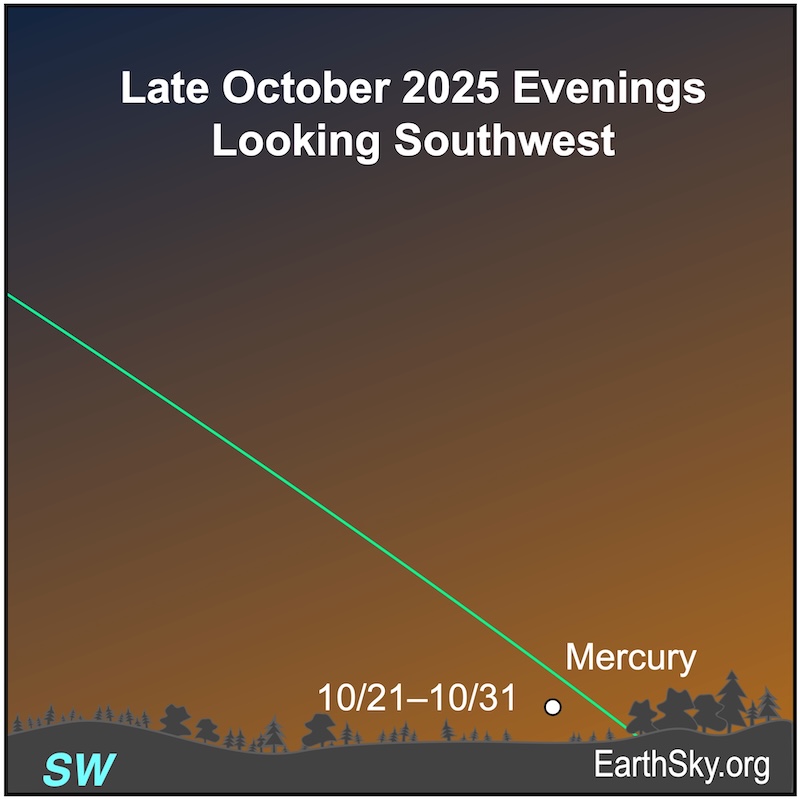 During late October, viewers in the Northern Hemisphere can look for Mercury low in the bright southwestern twilight about 30 minutes after sunset. The little planet will be difficult to spot. It’ll reach its greatest elongations from the evening sun on October 29. Southern Hemisphere observers can spot it through mid-November. Mercury moves through the constellations of Virgo the Maiden to Libra the Scales to Scorpius the Scorpion this month. Chart via EarthSky.
During late October, viewers in the Northern Hemisphere can look for Mercury low in the bright southwestern twilight about 30 minutes after sunset. The little planet will be difficult to spot. It’ll reach its greatest elongations from the evening sun on October 29. Southern Hemisphere observers can spot it through mid-November. Mercury moves through the constellations of Virgo the Maiden to Libra the Scales to Scorpius the Scorpion this month. Chart via EarthSky.
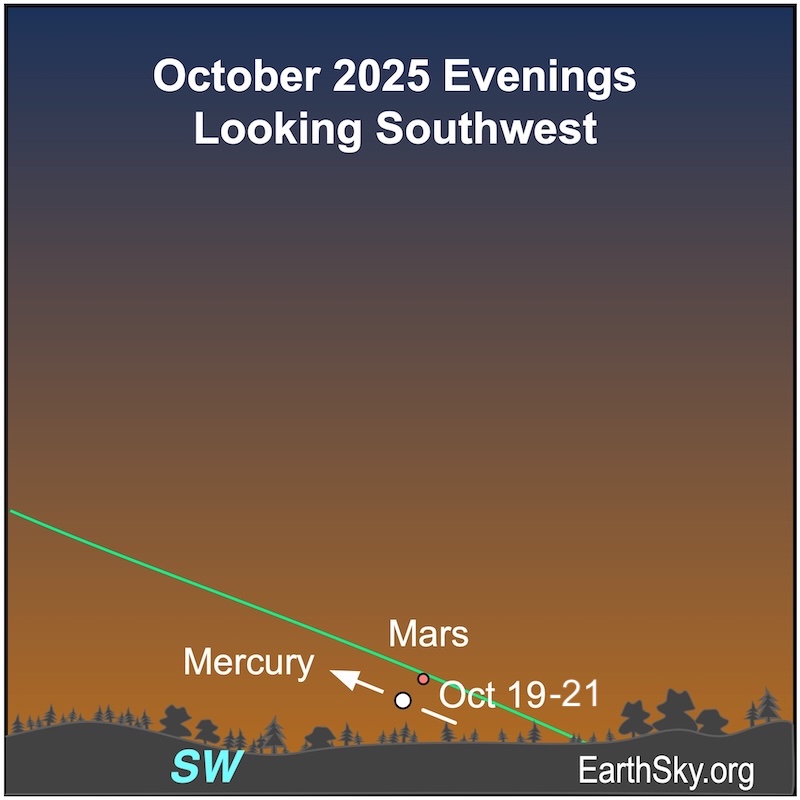 About 30 minutes after sunset on October 19, planet Mercury passed Mars very low on the southwestern horizon. They’ll be difficult to spot in the bright twilight. They’ll be closest on October 20 and 21. Binoculars might help spot the pair. Chart via EarthSky.
About 30 minutes after sunset on October 19, planet Mercury passed Mars very low on the southwestern horizon. They’ll be difficult to spot in the bright twilight. They’ll be closest on October 20 and 21. Binoculars might help spot the pair. Chart via EarthSky.
 You can spot Saturn in the east after sunset. It reached opposition — when Earth flew between Saturn and the sun — on September 21. Saturn is rising in the east before sunset and is visible until a few hours before dawn. Saturn will shine at 0.9 magnitude by month’s end is among the stars of Aquarius the Water Bearer. Saturn will remain visible in the evening sky for the rest of 2025. It’ll finally disappear in the sunset glare in February 2026. Chart via EarthSky.
You can spot Saturn in the east after sunset. It reached opposition — when Earth flew between Saturn and the sun — on September 21. Saturn is rising in the east before sunset and is visible until a few hours before dawn. Saturn will shine at 0.9 magnitude by month’s end is among the stars of Aquarius the Water Bearer. Saturn will remain visible in the evening sky for the rest of 2025. It’ll finally disappear in the sunset glare in February 2026. Chart via EarthSky.
Our charts are mostly set for the northern half of Earth. To see a precise view – and time – from your location, try Stellarium Online.
October morning planets
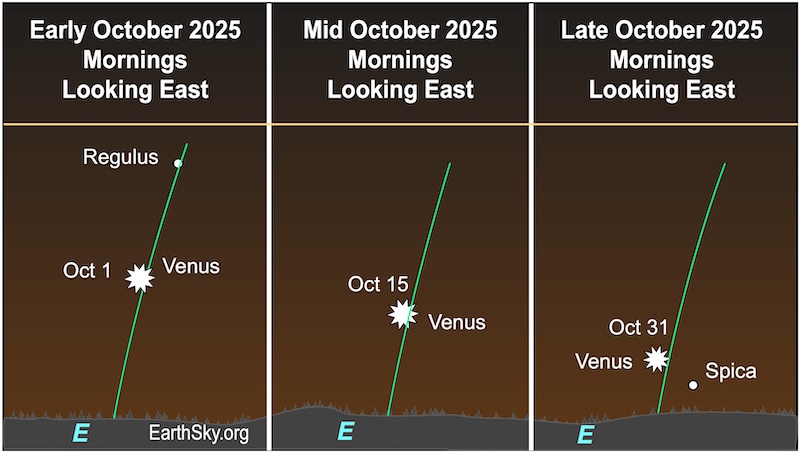 On the mornings of early October, brilliant Venus will lie between Regulus and the horizon. Mid-month, Venus will shine closer to the eastern horizon. After that, it will drop much closer to the horizon and will approach Spica, which has just reappeared in the morning sky. Venus moves from Leo the Lion to Virgo the Maiden this month. Chart via EarthSky.
On the mornings of early October, brilliant Venus will lie between Regulus and the horizon. Mid-month, Venus will shine closer to the eastern horizon. After that, it will drop much closer to the horizon and will approach Spica, which has just reappeared in the morning sky. Venus moves from Leo the Lion to Virgo the Maiden this month. Chart via EarthSky.
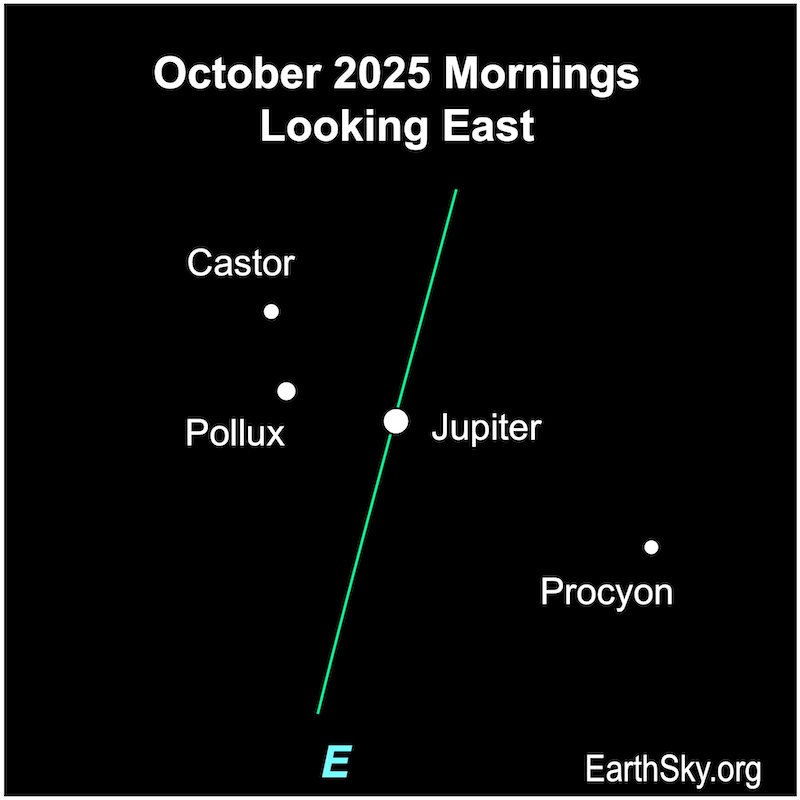 Bright Jupiter shines high in the east before sunrise all month. It’s between the twin stars of Gemini, Castor (the slightly dimmer one) and Pollux (the slightly brighter one) and the bright star Procyon. Chart via EarthSky.
Bright Jupiter shines high in the east before sunrise all month. It’s between the twin stars of Gemini, Castor (the slightly dimmer one) and Pollux (the slightly brighter one) and the bright star Procyon. Chart via EarthSky.
November evening planets
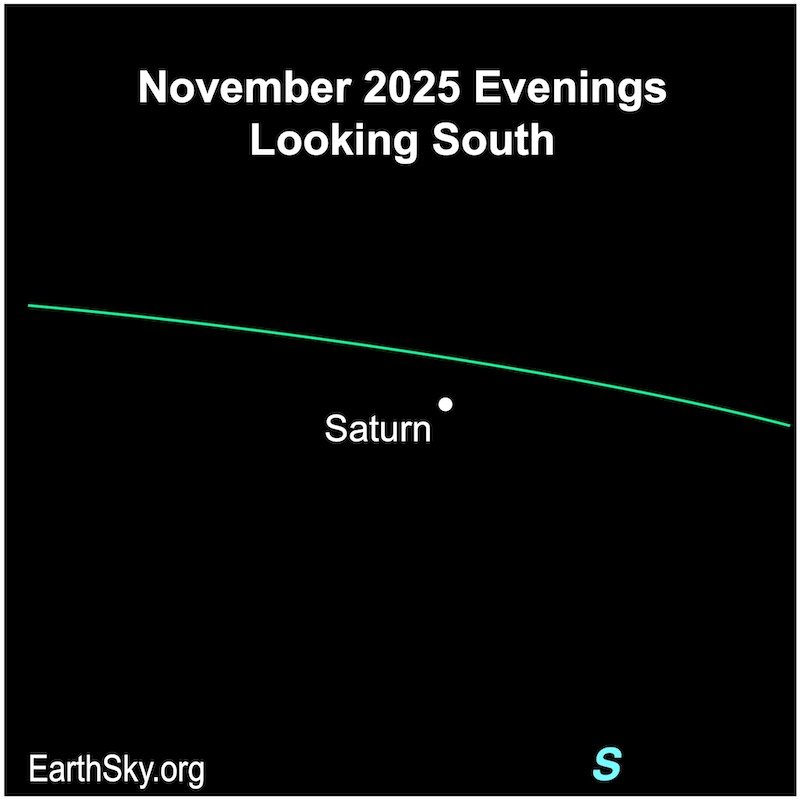 Saturn lies in the south in the evening hours of November. It is the brightest object in that part of the sky, other than the passing moon. It reached opposition — when Earth flew between Saturn and the sun — on September 21. Saturn is rising in the east before sunset and sets earlier each night after midnight. Saturn will shine at 1.1 magnitude by month’s end among the stars of Aquarius the Water Bearer. Saturn will remain visible in the evening sky for the rest of 2025. It’ll finally disappear in the sunset glare in February 2026. Chart via EarthSky.
Saturn lies in the south in the evening hours of November. It is the brightest object in that part of the sky, other than the passing moon. It reached opposition — when Earth flew between Saturn and the sun — on September 21. Saturn is rising in the east before sunset and sets earlier each night after midnight. Saturn will shine at 1.1 magnitude by month’s end among the stars of Aquarius the Water Bearer. Saturn will remain visible in the evening sky for the rest of 2025. It’ll finally disappear in the sunset glare in February 2026. Chart via EarthSky.
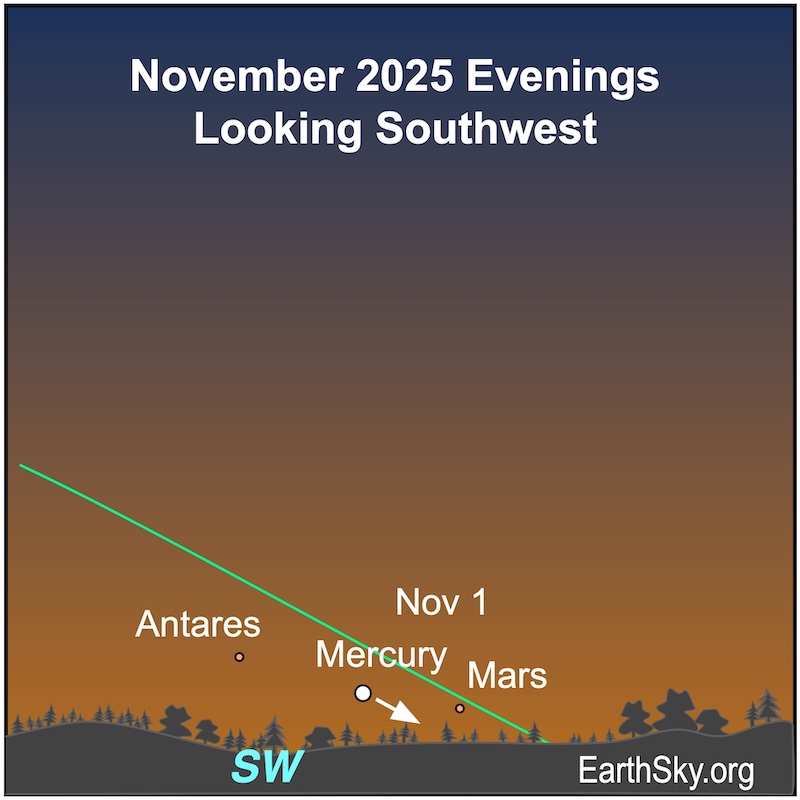 Around November 1, for observer’s in the Northern Hemisphere, Mercury and Mars lie very low and might be lost in the southwestern twilight. Mercury will be brighter and therefore easier to see than Mars. Plus, the star Antares will also be nearby. But it, too, will be challenging to spot in the twilight. Mars and Mercury soon drop out of the evening sky. Chart via EarthSky.
Around November 1, for observer’s in the Northern Hemisphere, Mercury and Mars lie very low and might be lost in the southwestern twilight. Mercury will be brighter and therefore easier to see than Mars. Plus, the star Antares will also be nearby. But it, too, will be challenging to spot in the twilight. Mars and Mercury soon drop out of the evening sky. Chart via EarthSky.
 From the Southern Hemisphere, Mercury and Mars lie below Antares in the southwest about 30 minutes after sunset. Observers in the Southern Hemisphere will have a better view of the planetary pair. On November 12, Mercury will pass the more difficult to see Mars. A few evenings later, Mercury and Mars will be lost in the bright evening twilight. Chart via EarthSky.
From the Southern Hemisphere, Mercury and Mars lie below Antares in the southwest about 30 minutes after sunset. Observers in the Southern Hemisphere will have a better view of the planetary pair. On November 12, Mercury will pass the more difficult to see Mars. A few evenings later, Mercury and Mars will be lost in the bright evening twilight. Chart via EarthSky.
Our charts are mostly set for the northern half of Earth. To see a precise view – and time – from your location, try Stellarium Online.
November morning planets
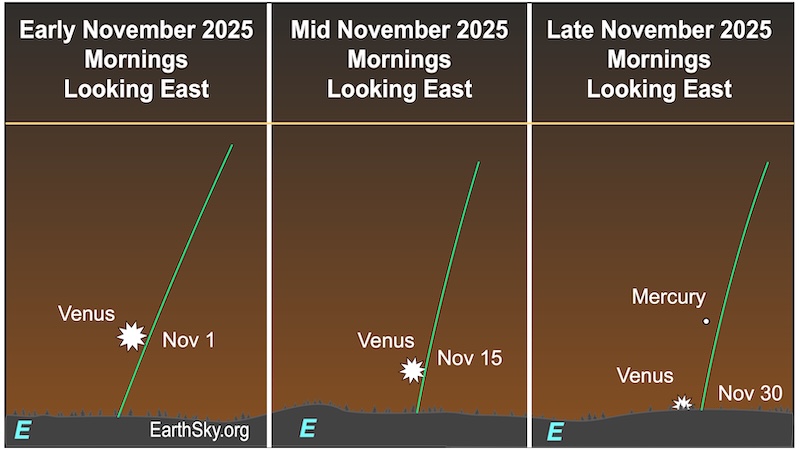 About 30 minutes before sunrise in early November, bright Venus will lie low above the eastern horizon. As the month progresses, the planet drops closer to the horizon, and it’ll become increasingly difficult to spot in the bright morning twilight. By the end of November, it will be lost in the sun’s glare. Mercury – on its way to its greatest distance from the morning sun on December 7 – will climb above Venus by the end of the month. Venus moves from Virgo the Maiden to Libra the Scales in November. Venus will emerge in the evening sky sometime around the beginning of March. Chart via EarthSky.
About 30 minutes before sunrise in early November, bright Venus will lie low above the eastern horizon. As the month progresses, the planet drops closer to the horizon, and it’ll become increasingly difficult to spot in the bright morning twilight. By the end of November, it will be lost in the sun’s glare. Mercury – on its way to its greatest distance from the morning sun on December 7 – will climb above Venus by the end of the month. Venus moves from Virgo the Maiden to Libra the Scales in November. Venus will emerge in the evening sky sometime around the beginning of March. Chart via EarthSky.
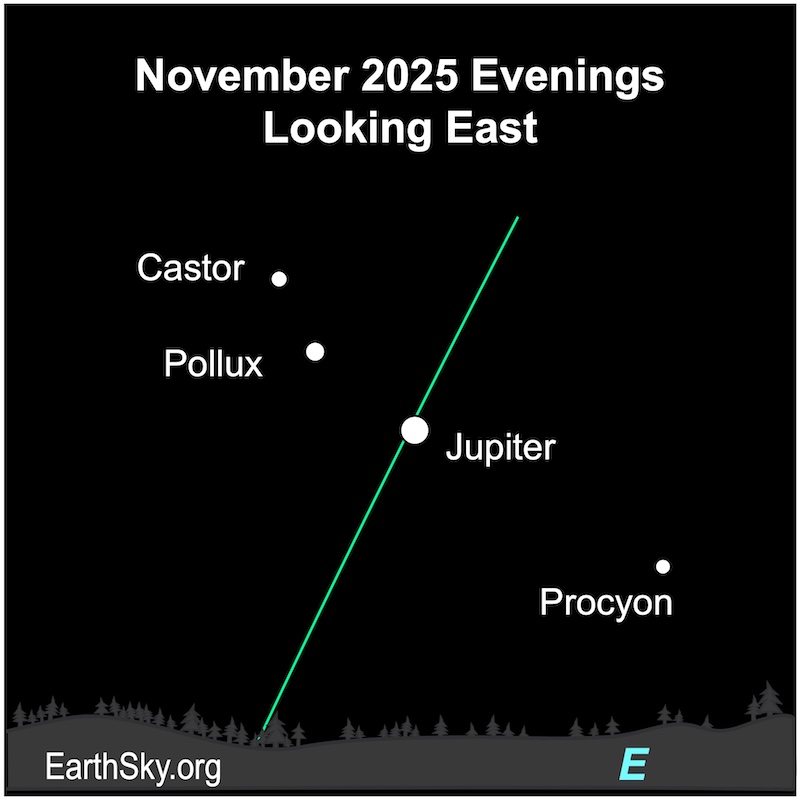 Bright Jupiter shines high in the east before sunrise all month. And it’ll rise earlier each night and be visible several hours after sunset by month’s end. It’s near the twin stars of Gemini, Castor (the slightly dimmer one) and Pollux (the slightly brighter one) and the bright star Procyon. Chart via EarthSky.
Bright Jupiter shines high in the east before sunrise all month. And it’ll rise earlier each night and be visible several hours after sunset by month’s end. It’s near the twin stars of Gemini, Castor (the slightly dimmer one) and Pollux (the slightly brighter one) and the bright star Procyon. Chart via EarthSky.
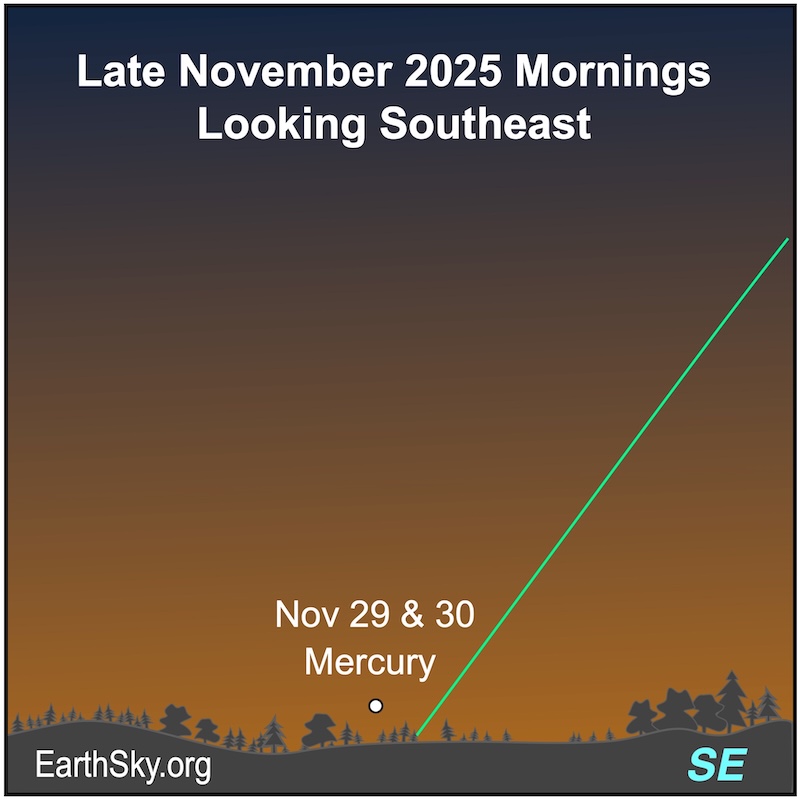 During the last 2 mornings of November for viewers in the Northern Hemisphere, Mercury will lie very low in the bright morning twilight about 30 minutes before sunrise. The little planet will be difficult to spot. It will be very low for viewers in the Southern Hemisphere, too. It’ll reach its greatest distance from the morning sun on December 7. Chart via EarthSky.
During the last 2 mornings of November for viewers in the Northern Hemisphere, Mercury will lie very low in the bright morning twilight about 30 minutes before sunrise. The little planet will be difficult to spot. It will be very low for viewers in the Southern Hemisphere, too. It’ll reach its greatest distance from the morning sun on December 7. Chart via EarthSky.
Sky dome map for visible planets and night sky
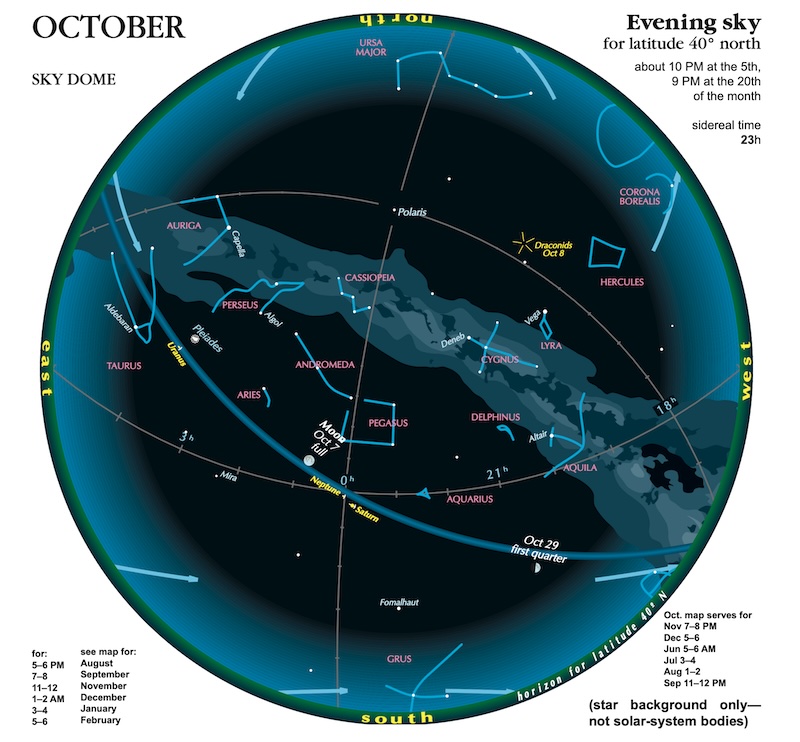 Here is the sky dome view for October 2025. It shows what is above the horizon at mid-evening for mid-northern latitudes. The view may vary depending on your location. Image via Guy Ottewell’s 2025 Astronomical Calendar.
Here is the sky dome view for October 2025. It shows what is above the horizon at mid-evening for mid-northern latitudes. The view may vary depending on your location. Image via Guy Ottewell’s 2025 Astronomical Calendar.
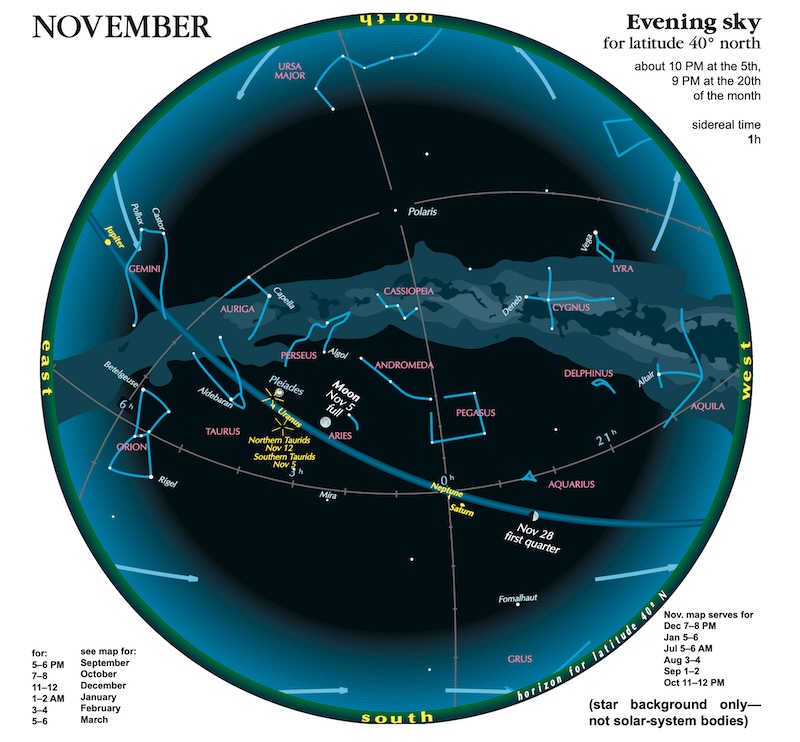 Here is the sky dome view for November 2025. It shows what is above the horizon at mid-evening for mid-northern latitudes. The view may vary depending on your location. Image via Guy Ottewell’s 2025 Astronomical Calendar.
Here is the sky dome view for November 2025. It shows what is above the horizon at mid-evening for mid-northern latitudes. The view may vary depending on your location. Image via Guy Ottewell’s 2025 Astronomical Calendar.
Read more: Guy Ottewell explains sky dome maps.
Heliocentric solar system visible planets and more
 Heliocentric view of solar system, October 2025. Chart via Guy Ottewell’s 2025 Astronomical Calendar. Used with permission.
Heliocentric view of solar system, October 2025. Chart via Guy Ottewell’s 2025 Astronomical Calendar. Used with permission.
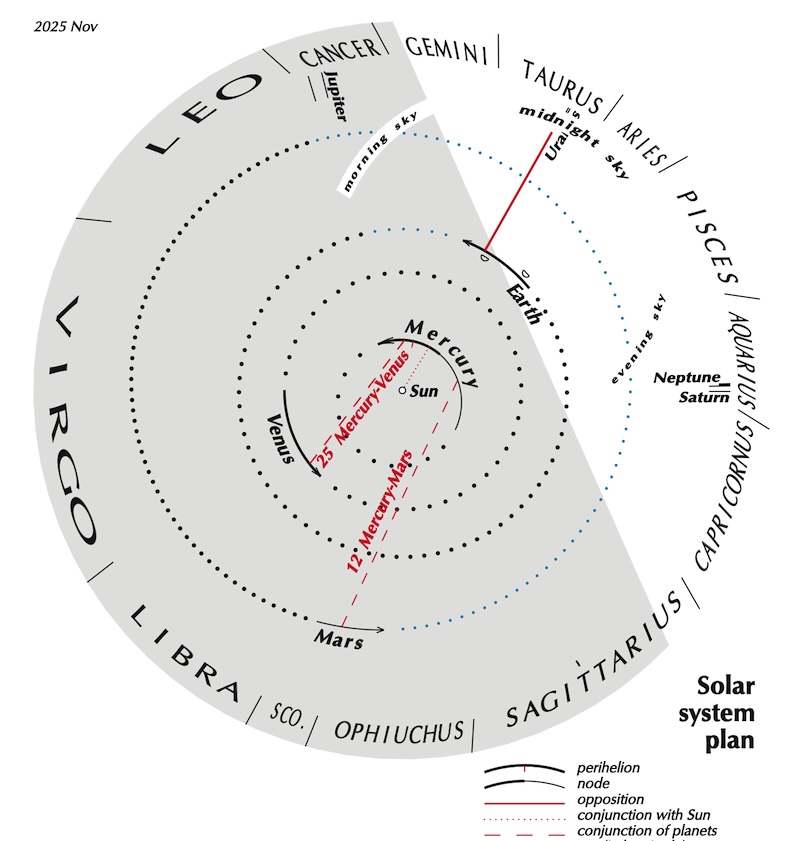 Heliocentric view of solar system, November 2025. Chart via Guy Ottewell’s 2025 Astronomical Calendar. Used with permission. Plus, Guy Ottewell explains heliocentric charts here.
Heliocentric view of solar system, November 2025. Chart via Guy Ottewell’s 2025 Astronomical Calendar. Used with permission. Plus, Guy Ottewell explains heliocentric charts here.
Read more: Guy Ottewell explains heliocentric charts.
Some resources to enjoy
For more videos of great night sky events, visit EarthSky’s YouTube page.
Don’t miss anything. Subscribe to daily emails from EarthSky. It’s free!
Visit EarthSky’s Best Places to Stargaze to find a dark-sky location near you.
Post your own night sky photos at EarthSky Community Photos.
See the indispensable Observer’s Handbook, from the Royal Astronomical Society of Canada.
Visit Stellarium-Web.org for precise views from your location.
Almanac: Bright visible planets (rise and set times for your location).
Visit TheSkyLive for precise views from your location.
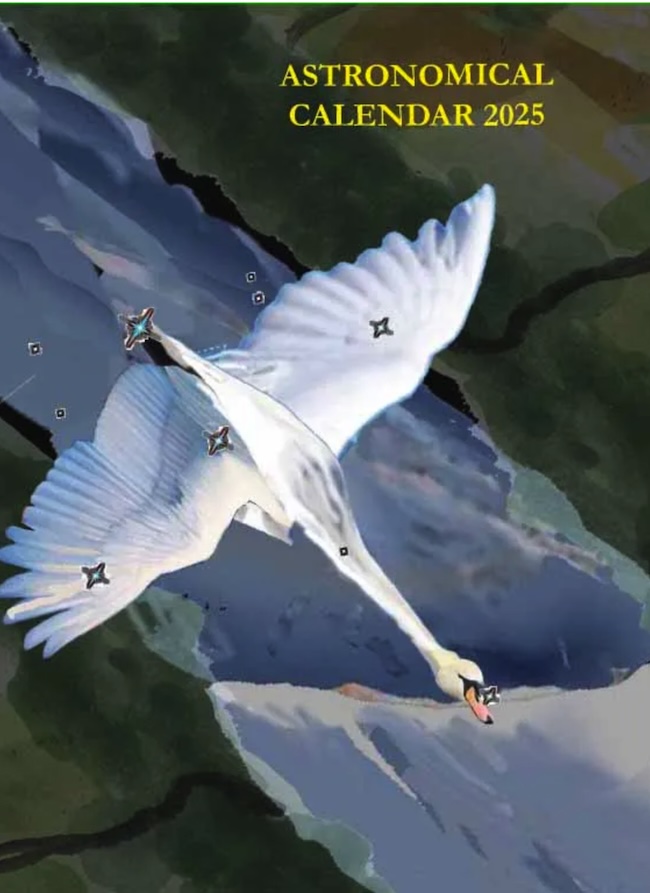 Attention amateur astronomers! Guy Ottewell’s popular and informative Astronomical Calendar for 2025 is available in both electronic and printed versions.
Attention amateur astronomers! Guy Ottewell’s popular and informative Astronomical Calendar for 2025 is available in both electronic and printed versions.
Bottom line: Visible planets and night sky guide. Tonight just after sunset, look for the waxing crescent moon hanging near the red star Antares. You might bea able to spot three comets in the coming weeks! See a video.
Marcy Curran
View Articles
About the Author:
Meet Marcy Curran, our voice of the night sky on EarthSky YouTube. Check out her popular short videos in the Sky category on our YouTube channel. When she’s not making videos, Marcy is an EarthSky editor, helping to keep our night sky guide up-to-date and just generally helping to keep the wheels turning around here. Marcy has enjoyed stargazing since she was a child, going on family camping trips under the dark skies of Wyoming. She bought her first telescope in time to see Halley’s Comet when it visited the inner solar system in 1986. She co-founded her local astronomy club and remains an active board member. Marcy taught astronomy at her local community college for over 20 years. She and her husband live in Wyoming, in a rural location, with an all-sky camera and super-good horizon views! And, their observatory will soon be ready to photograph the night sky.
John Jardine Goss
View Articles
About the Author:
“I can sometimes see the moon in the daytime” was a cosmic revelation that John Jardine Goss first discovered through personal observations at age 6. It shook his young concept of the universe and launched his interest in astronomy and stargazing, a fascination he still holds today. John is past president of the Astronomical League, the largest U.S. federation of astronomical societies, with over 24,000 members. He’s earned the title of Master Observer and is a regular contributor to the video series, “Global Star Party.” He has authored the celestial observing guides “Exploring the Starry Realm,” and “Carpe Lunam,” and “Take Your First Steps, an Introduction to Amateur Astronomy.” John also wrote for twenty years the monthly stargazing column, Roanoke Skies, for the Roanoke Times, and currently writes a bimonthly column, Skywatch, for Blue Ridge Country magazine. He has contributed to Sky and Telescope magazine, the IDA Nightscape, the Astronomical League’s Reflector magazine, and the RASC Observer’s Handbook.
Deborah Byrd
View Articles
About the Author:
Our Editor-in-Chief Deborah Byrd works to keep all the astronomy balls in the air between EarthSky’s website, YouTube page and social media platforms. She’s the primary editor of our popular daily newsletter and a frequent host of EarthSky livestreams. Deborah created the EarthSky radio series in 1991 and founded EarthSky.org in 1994. Prior to that, she had worked for the University of Texas McDonald Observatory since 1976, and created and produced their Star Date radio series. She has won a galaxy of awards from the broadcasting and science communities, including having an asteroid named 3505 Byrd in her honor. In 2020, she won the Education Prize from the American Astronomical Society, the largest organization of professional astronomers in North America. A science communicator and educator since 1976, Byrd believes in science as a force for good in the world and a vital tool for the 21st century. “Being an EarthSky editor is like hosting a big global party for cool nature-lovers,” she says.
Kelly Kizer Whitt
View Articles
About the Author:
Kelly Kizer Whitt – EarthSky’s nature and travel vlogger on YouTube – writes and edits some of the most fascinating stories at EarthSky.org. She’s been writing about science, with a focus on astronomy, for decades. She began her career at Astronomy Magazine and made regular contributions to other outlets, including AstronomyToday and the Sierra Club. She has nine published books, including a children’s picture book, Solar System Forecast, and a young adult dystopian novel, A Different Sky.
